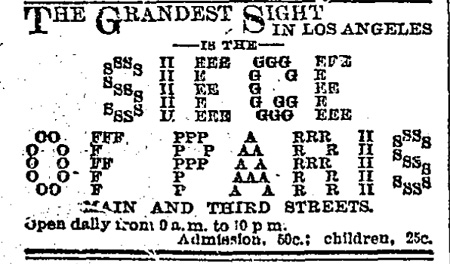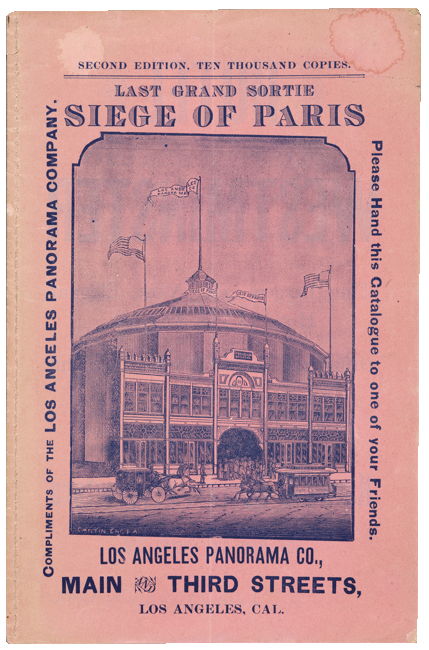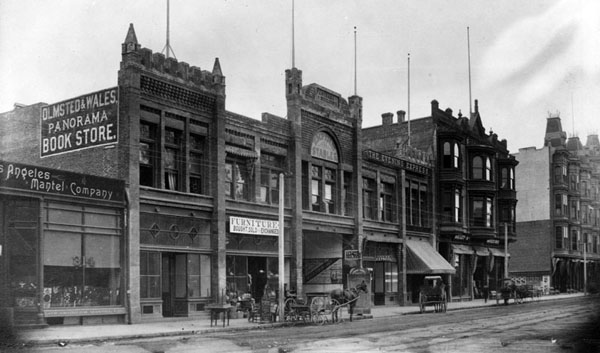Panoramas In Los Angeles
PANORAMA OF THE SIEGE OF PARIS
Many American cities built their own grand panorama rotundas during the 1880s and 1890s, magnificent public halls which could either hold a permanent exhibit or be host to the many traveling, short-term attractions which dominated 19th-century public entertainment.
Downtown Los Angeles debuted a panoramic exhibit in late 1887 at Main Street between Third and Fourth Streets - the Panorama of the Siege of Paris. This attraction depicted a devastating episode in the 1870-71 Franco-Prussian war-- the last battle between the French resistance and Prussian 'besiegers' after which Paris fell in January of 1871.
Panorama Rotunda at Third and Main Streets in Los Angeles, late 1880s - seen from the rear.
The Siege of Paris painting displayed in Los Angeles was a faithful copy of the hugely successful Paris original, Panorama of the Defence of Paris Against the Prussian Armies by the renowned French salon painter Henri Felix Emmanuel Philippoteaux. This original painting opened in Paris not long after the events of the siege itself, and its popularity was due in part to the portrayal of a heroic French resistance. The American copy, by Philippoteaux himself, arrived in Los Angeles in 1887 after having been exhibited in New York, Boston, and Chicago.
Inspired by the financial and critical success of several Civil War-themed panoramas (most notably The Battle of Gettysburg by Henri Felix Philippoteax's son Paul), the idea to build a panorama rotunda in Los Angeles occurred at the height of the city's land speculation boom, and was seen as an important addition to the cultural life of a city in the midst of a nationwide advertising campaign to attract new residents to the area. The Los Angeles Panorama Company originally incorporated for a period of fifty years, suggesting that the stockholders' hoped the Siege of Paris would be just the first of many traveling exhibitions to be displayed in the city. The painting was purported to be nearly 400 feet long and 50 feet high, and a visit was complemented by hourly lectures on the subject of the work by a Mr. J.C. Cameron.
From the 'Amusements' section, Los Angeles Times, May 27, 1888
Souvenir Booklet Cover, Collection of the Huntington Library
Within a year of its construction, the brick storefront on Main Street through which panorama visitors entered - fittingly called the ''Panorama Building"- was home to many business ventures, with owners quickly capitalizing on the prestige of the art work and its instantly recognizable address. Over several years the building held a warehouse for the Bancroft Piano Company; a rehearsal hall for the vocal section of the Philharmonic Society; the meeting space for the Young Man's Prohibition Club as well as the Harrison and Morton Club, a Republican party group; and Miss B.M. Tobin's millinery, directly adjacent to the offices of W.O. Merithew, architect. The Evening Express newspaper had its offices in the building, and the Olmstead and Wales Panorama Bookstore was also an early tenant.
Panorama Building, 1890s
When the panorama venture began to lose money and personal financial troubles further beset the primary investors in the parent stock company (which included local landowner and capitalist Daniel Freeman), the painting was sold to exhibitors in San Francisco and the rotunda began to take on an array of ventures suitable to the building's magnificent size but far removed from its original artistic intent. Throughout the 1890s and early 1900s, the rotunda housed Empire Stables, as seen in the above image. In 1906 it was configured into a grand state-of-the-art roller skating rink, promising exercise and enjoyment for all ages, shown in advertisements touting polite instructors and special lunchtime classes for business people.Unfortunately, it didn't last long as a skating venue. In 1907, the owner of the property, Adolph Ramish, demolished the building and made plans to construct the Adolphus Theatre on the site, later to be called the Hippodrome.
Given the history of panorama exhibition in most cosmopolitan American cities in 19th century, Angelenos can be proud that their city was host to one of the grandest and important panoramas of the era.
Research conducted by J. Finlinson and Noe Neria. Many thanks to Suzanne Wray, the Huntington Library, Loyola Marymount University Archives & Special Collections, and Los Angeles Public Library Archives for information and images on this page.



